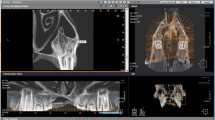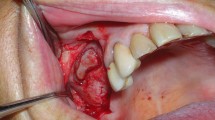Abstract
Purpose
This study aimed to compare the differences among Piezosurgery, CAS-kit, and Osteotome regarding safe elevation, perforation rate, and time spent and to observe and analyze different sinus lifting efficacy of the three methods.
Materials and Methods
Twenty-one fresh goat heads (42 sinuses) were investigated. CBCT images confirmed the feasibility of the goat model. The maxillary sinus was successively lifted to 5, 7, and 9 mm by Piezosurgery, CAS-kit, and Osteotome until the sinus membrane was perforated or lifted to 9 mm. In the end, final elevation, sinus perforation, and time spent were recorded.
Results
Piezosurgery and CAS-kit lifted sinuses to relatively higher heights than did Osteotome (P = 0.000). Perforation rates (14.29, 21.43%) of the Piezosurgery and CAS-kit were far lower than that of the Osteotome (85.71%). In the Osteotome group, the time of lifting to 9 mm was significantly shorter than that of Piezosurgery and CAS-kit (P = 0.000). There was no statistical difference in time spent between the latter two (P = 0.115).
Conclusions
The lifting height of the Osteotome was limited, but it took the shortest time for sinus lifting. Piezosurgery and CAS-kit had higher lifting heights and lower perforation rates compared with Osteotome.










Similar content being viewed by others
References
Padhye NM, Bhatavadekar NB (2020) Quantitative assessment of the edentulous posterior maxilla for implant therapy: a retrospective cone beam computed tomographic study. J Maxillofac Oral Surg 19(1):125–130. https://doi.org/10.1007/s12663-019-01236-7
Summers RB (1994) A new concept in maxillary implant surgery: the osteotome technique. Compendium 15(2):152–154
Elian S, Barakat K (2018) Crestal endoscopic approach for evaluating sinus membrane elevation technique. Int J Implant Dent 4(1):15. https://doi.org/10.1186/s40729-018-0126-6
Sotirakis EG, Gonshor A (2005) Elevation of the maxillary sinus floor with hydraulic pressure. J Oral Implantol 31(4):197–204. https://doi.org/10.1563/1548-1336(2005)31[197:EOTMSF]2.0.CO;2
Vercellotti T, De Paoli S, Nevins M (2001) The piezoelectric bony window osteotomy and sinus membrane elevation: introduction of a new technique for simplification of the sinus augmentation procedure. Int J Periodontics Restor Dent 21(6):561–567
Troedhan AC, Kurrek A, Wainwright M, Jank S (2010) Hydrodynamic ultrasonic sinus floor elevation-an experimental study in sheep. J Oral Maxillofac Surg 68(5):1125–1130. https://doi.org/10.1016/j.joms.2009.12.014
Fan J, Hu P, Li Y et al (2017) Goat model for direct visualizing the effectiveness of detaching sinus mucosa in real time during crestalmaxillary sinus floor elevation. J Oral Implantol 43(4):247–253. https://doi.org/10.1563/aaid-joi-D-16-00102
López-Niño J, García-Caballero L, González-Mosquera A, Seoane-Romero J, Varela-Centelles P, Seoane J (2012) Lamb ex vivo model for training in maxillary sinus floor elevation surgery: a comparative study with human standards. J Periodontol 83(3):354–361. https://doi.org/10.1902/jop.2011.110210
Călin C, Petre A, Drafta S (2014) Osteotome-mediated sinus floor elevation: a systematic review and meta-analysis. Int J Oral Maxillofac Implants 29(3):558–576. https://doi.org/10.11607/jomi.3206
Catros S, Montaudon M, Bou C, Da Costa NR, Fricain JC, Ella B (2015) Comparison of conventional transcrestal sinus lift and ultrasound-enhanced transcrestalhydrodynamic cavitational sinus lift for the filling of subantral space: a human cadaver study. J Oral Implantol 41(6):657–661. https://doi.org/10.1563/aaid-joi-D-14-00038
Gargallo-Albiol J, Tattan M, Sinjab KH, Chan HL, Wang HL (2019) Schneiderian membrane perforation via transcrestal sinus floor elevation: a randomized ex vivo study with endoscopic validation. Clin Oral Implants Res 30(1):11–19. https://doi.org/10.1111/clr.13388
Malzoni CMA, Nicoli LG, Pinto GDCDS et al (2020) The effectiveness of L-PRF in the treatment of Schneiderian membrane large perforations: long-term follow-up of a case series. J Oral Implantol 47(1):31–35. https://doi.org/10.1563/aaid-joi-D-20-00044
Yassin Alsabbagh A, Alsabbagh MM, Darjazini Nahas B, Rajih S (2017) Comparison of three different methods of internal sinus lifting for elevation heights of 7 mm: an ex vivo study. Int J Implant Dent 3(1):40. https://doi.org/10.1186/s40729-017-0103-5
Bensaha T (2011) Evaluation of the capability of a new water lift system to reduce the risk of Schneiderian membrane perforation during sinus elevation. Int J Oral Maxillofac Surg 40(8):815–820. https://doi.org/10.1016/j.ijom.2011.04.005
Li J, Lee K, Chen H, Ou G (2013) Piezoelectric surgery in maxillary sinus floor elevation with hydraulic pressure for xenograft and simultaneous implant placement. J Prosthet Dent 110(5):344–348. https://doi.org/10.1016/j.prosdent.2013.04.002
Kirpalani T, Dym H (2020) Role of piezo surgery and lasers in the oral surgery office. Dent Clin North Am 64(2):351–363. https://doi.org/10.1016/j.cden.2019.12.007
Jank S, Kurrek A, Wainwright M, Bek VE, Troedhan A (2011) Rupture length of the sinus membrane after 1.2 mm puncture and surgical sinus elevation: an experimental animal cadaver study. Oral Surg Oral Med Oral Pathol Oral Radiol Endod 112(5):568–72. https://doi.org/10.1016/j.tripleo.2010.11.014
Dong Z, Yao C, Zhang Y, Chen G, Yuan Q, Xu J (2016) Hydrodynamics and mass transfer of oscillating gas-liquid flow in ultrasonic microreactors. AIChE J 62(4):1294–1307. https://doi.org/10.1002/aic.15091
Troedhan A, Kurrek A, Wainwright M, Jank S (2014) Schneiderian membrane detachment using transcrestalhydrodynamic ultrasonic cavitational sinus lift: a human cadaver head study and histologic analysis. J Oral Maxillofac Surg 72(8):1503.e1–10. https://doi.org/10.1016/j.joms.2014.02.021
Zheng X, Teng M, Zhou F, Ye J, Li G, Mo A (2016) Influence of maxillary sinus width on transcrestal sinus augmentation outcomes: radiographic evaluation based on cone beam CT. Clin Implant Dent Relat Res 18(2):292–300. https://doi.org/10.1111/cid.12298
Srouji S, Kizhner T, Ben David D, Riminucci M, Bianco P, Livne E (2009) The Schneiderian membrane contains osteoprogenitor cells: in vivo and in vitro study. Calcif Tissue Int 84(2):138–145. https://doi.org/10.1007/s00223-008-9202-x
Garrido-Serrano R, Azcárate-Velázquez F, Núñez-Arcos P (2015) Anatomic analysis of the maxillary sinus: preliminary morphologic comparison of animal models (pig, lamb, and human). J Oral Implantol 41(4):495–499. https://doi.org/10.1563/AAID-JOI-D-13-00363
de Oliveira HF, Bollela VR, Anselmo-Lima WT, Costa CAPO, Nakanishi M (2017) A feasible, low-cost, reproducible lamb’s head model for endoscopic sinus surgery training. PLoS ONE 12(6):e0180273. https://doi.org/10.1371/journal.pone.0180273
Funding
This study had received support from the National Natural Science Foundation of China and the key R&D projects of Shanxi Province. National Natural Science Foundation of China, 82003146, Jue Wang, Shanxi Provincial Key Research and Development Project, 201903D321090, Jue Wang.
Author information
Authors and Affiliations
Contributions
H Wu, Prof. F Yawei and J Wang, MD, participated in experiment design. H Wu and Prof. F Yawei were involved in experimental operation. H Wu was involved in data analysis, result interpretation, article drafting and revision. Prof. F Yawei gave guidance and was involved in key revision and approval of the paper. J Wang, MD, participated in article modification and responsible for fund guarantee. C Wang, X Yang, Q Gong, W Su, and A Cheng were involved in goat model making and participated in the experiment, experimental photography, and data recording.
Corresponding author
Ethics declarations
Conflict of interest
The authors state that there are no conflicts of interest in this article.
Additional information
Publisher's Note
Springer Nature remains neutral with regard to jurisdictional claims in published maps and institutional affiliations.
Rights and permissions
Springer Nature or its licensor holds exclusive rights to this article under a publishing agreement with the author(s) or other rightsholder(s); author self-archiving of the accepted manuscript version of this article is solely governed by the terms of such publishing agreement and applicable law.
About this article
Cite this article
Wu, H., Wang, J., Wang, C. et al. A Comparison of Elevation, Perforation Rate, and Time Spent for the Crestal Sinus Elevation Intervened by Piezosurgery, CAS-Kit, and Osteotome in a Novel Goat Model. J. Maxillofac. Oral Surg. 21, 1191–1198 (2022). https://doi.org/10.1007/s12663-022-01793-4
Received:
Accepted:
Published:
Issue Date:
DOI: https://doi.org/10.1007/s12663-022-01793-4




